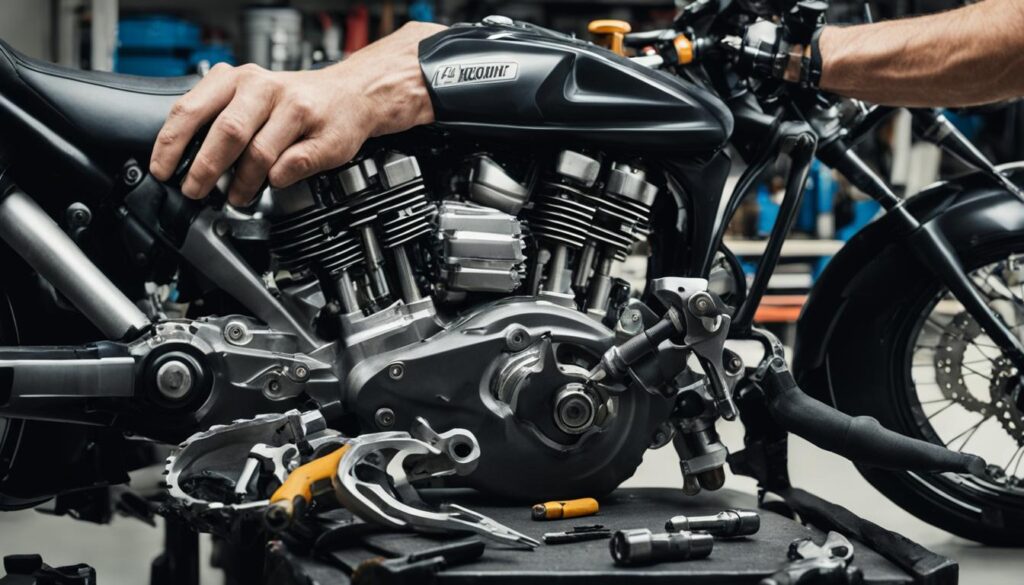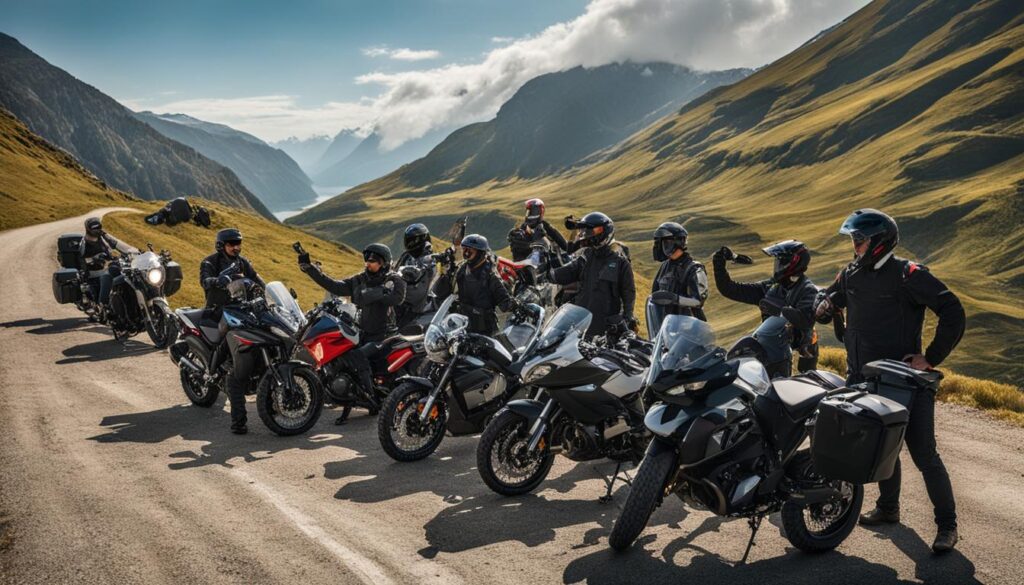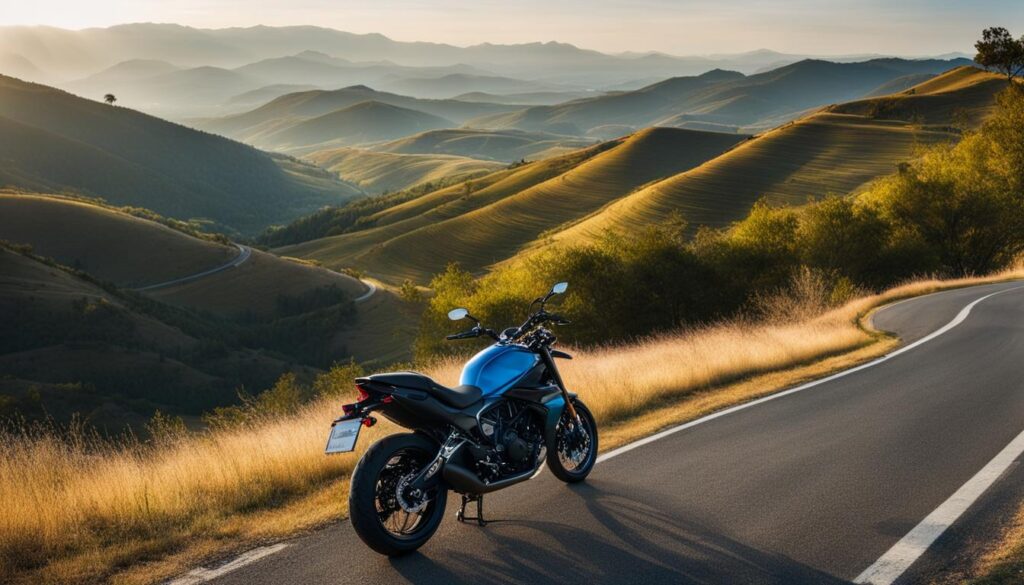If you’re planning a motorcycle trip, it’s important to consider various factors to ensure a safe and enjoyable journey. Motorcycle travel tips and considerations are essential for riders to make the most out of their adventure. Whether you’re a seasoned biker or a beginner, this article covers essential tips and guidelines to get you ready for your next motorcycle trip.
From packing efficiently to staying safe on the road, these tips will help you make the most of your journey. So gear up, get ready, and let’s explore the world on two wheels!
Essential Motorcycle Travel Gear
When preparing for a motorcycle travel adventure, having the essential gear can make all the difference. The right gear not only ensures your safety, but also your comfort throughout the journey.
At the top of the list is the helmet. Make sure it fits well and meets safety standards. A full face helmet provides the best protection for your head, face, and eyes.
A good riding jacket is also crucial. Look for one with armor in the elbows, shoulders, and back. It should also be made of durable and weather-resistant material to protect you from wind and rain.
Gloves are another essential item. They not only protect your hands from cold and wind, but also provide traction for better grip on the handlebars.
| Item | Description |
|---|---|
| Riding boots | A sturdy and comfortable pair of boots should be at the top of your list, providing good ankle support, and traction on foot pegs and the road. |
| Riding pants | When you’re on the road, comfort is key, so you’ll want a good pair of riding pants to protect against wind, rain, and cold temperatures. Look for pants with padding in the knees and hips. |
| Earplugs | The wind noise and engine roar can be deafening during long rides. So consider bringing earplugs to protect your hearing. |
Don’t forget to pack a toolkit and tire repair kit in case of any mechanical issues on the road.
Overall, investing in good quality gear is worth every penny. It ensures you have a safe and comfortable ride, no matter where the road takes you.
Motorcycle Maintenance Tips
Regular maintenance is crucial for ensuring safe and smooth travels on your motorcycle. By following some basic maintenance tips, you can avoid breakdowns, extend the life of your bike, and enjoy your adventure to the fullest.
Tire Pressure Check
Ensure proper tire pressure on both wheels to prevent tire wear and tear and improve fuel efficiency. Refer to the motorcycle owner’s manual for the recommended tire pressure, and check pressure levels at least once a week with a tire pressure gauge.
Oil Level Check
Checking oil levels regularly is essential to keep your motorcycle’s engine in good condition. To check the oil level, park the motorcycle on a level surface, warm up the engine, let it cool down for a few minutes, and use a dipstick to check the oil level as per the manufacturer’s instruction.
Brake Inspection
Regular inspection and maintenance of braking components are crucial for optimal performance and safe travels. Check the brake pads and brake fluid levels regularly, and replace the brake pads when they wear out. Also, make sure the brake levers and pedals are functioning correctly.
Chain Maintenance
The chain drive is a critical component for your motorcycle’s propulsion. To ensure the chain is in good condition, clean and lubricate it regularly. Refer to the manufacturer’s instructions for the recommended lubricant and frequency of application.
Battery Inspection
The battery is vital for starting your motorcycle. Regularly check the battery’s voltage and inspect it for any signs of corrosion. If the battery is more than three years old, consider replacing it.
By following these simple maintenance tips, you can keep your motorcycle in tip-top shape and ensure safe travels while on the road.
Planning a Motorcycle Road Trip
Embarking on a motorcycle road trip requires proper planning to ensure a smooth and exciting journey. Here are some essential steps for successful motorcycle road trip planning:
Choose Your Destinations
The first step in planning a motorcycle road trip is to decide on your destinations. Whether you plan to visit national parks or explore scenic routes, it’s best to choose destinations that align with your interests and travel style. Research attractions and landmarks along the way to make your trip more enjoyable and exciting.
Map Your Route
Once you have chosen your destinations, it’s time to map your route. Planning a route takes more than simply choosing the quickest or shortest path. Consider the road conditions, traffic, and weather forecasts. Also, plan rest breaks and fuel stops to ensure you won’t run out of gas while riding.
Consider Weather Conditions
Weather can significantly impact your motorcycle road trip, so it’s crucial to keep an eye on the forecast. Plan your trip around favorable weather conditions, and pack for all possible scenarios. Bring rain gear, extra layers for cold weather, and protective clothing for extreme heat.
Pack Efficiently
Packing efficiently for a motorcycle road trip can be challenging, as you have limited storage space. Choose versatile clothing items that can be mixed and matched, and pack lightweight and compact camping gear if you plan to camp along the way. Bring essential tools and spare parts, and pack them securely to prevent damage during the trip.
Motorcycle Travel Safety Precautions
When it comes to motorcycle travel, safety should always be a top concern. Whether you’re a seasoned rider or new to the game, it’s important to take precautions to ensure a safe and smooth journey. Here are some tips to help you stay safe on the roads:
Defensive Riding
One of the best ways to stay safe on a motorcycle is to practice defensive riding. This means always being aware of your surroundings and anticipating potential risks. Stay visible to other motorists by wearing reflective gear and ride with your headlights on. Avoid blind spots and always assume that other drivers cannot see you. Keep a safe distance from other vehicles and be prepared to react quickly to any sudden changes on the road.
Proper Gear
Wearing proper gear is essential to staying safe while riding a motorcycle. Always wear a DOT-approved helmet, riding jacket, gloves, and boots. Protective gear can help in the event of a fall or accident, reducing the risk of serious injuries.
Be Prepared for Emergencies
Even with the best preparation, emergencies can happen on the road. Be sure to carry a basic toolkit, spare parts, and a first aid kit with you at all times. Being prepared can help you handle minor issues on the road and stay safe until help arrives.
Stay Alert and Focused
Motorcycle travel requires your full attention and focus. Avoid distractions such as using your phone or listening to music while riding. Stay alert and keep your eyes on the road at all times. Take breaks as needed and avoid riding when you’re tired or fatigued.
Know Your Limits
Finally, it’s important to know your limits when it comes to motorcycle travel. Don’t attempt to ride beyond your skill level or in conditions that are beyond your comfort zone. Be honest with yourself about your abilities and stay within safe limits to ensure an enjoyable and safe ride.
Motorcycle Travel Destinations
As a motorcycle enthusiast, exploring some of the best travel destinations across the United States is an opportunity that you wouldn’t want to miss. The country’s vast landscape offers breathtaking scenery, iconic roads, national parks, and beautiful coastlines for riders to explore. Here are some motorcycle travel destinations that should be on your bucket list:
The Tail of the Dragon
If you are looking for an exciting and adrenaline-filled ride, the Tail of the Dragon is a must-visit destination. Located in Tennessee, this legendary stretch of road features 318 curves in just 11 miles, making it one of the most challenging roads for motorcycle riders. But the stunning mountain views and the thrill of the ride are well worth it.
Route 66
For a classic American motorcycle road trip, Route 66 is the way to go. Covering a distance of 2,448 miles, this iconic road stretches from Chicago, Illinois to Santa Monica, California, passing through eight states along the way. Riding on Route 66, you will not only experience the beauty of America’s heartland, but also immerse yourself in a rich cultural history.
Blue Ridge Parkway
If you are a fan of scenic rides, the Blue Ridge Parkway won’t disappoint. This 469-mile road winds along the Appalachian Mountains from Virginia to North Carolina, offering spectacular views of the mountains, forests, and valleys. The road is also surrounded by charming rural towns, historic landmarks, and recreational areas, making it an ideal ride for those who enjoy stops along the way.
Florida Keys
For a tropical motorcycle adventure, the Florida Keys offer a unique, laid-back atmosphere that you won’t find anywhere else. Riding along the Overseas Highway from Key Largo to Key West, you will be immersed in stunning ocean views, picturesque bridges, and charming seaside towns. The Florida Keys are also known for their incredible seafood and vibrant nightlife, making it a perfect destination for a motorcycle trip with friends.
| Destination | Features |
|---|---|
| Tail of the Dragon | 318 curves in 11 miles, stunning mountain views |
| Route 66 | Covers 8 states, cultural history, scenic ride |
| Blue Ridge Parkway | 469-mile road along the Appalachian Mountains, spectacular views, rural towns |
| Florida Keys | Tropical atmosphere, beach views, seafood, and nightlife |
Whether you are an experienced motorcycle rider or a beginner, there is a destination out there that is perfect for you. Just remember to prioritize safety, plan your route ahead of time, and enjoy the adventure of exploring America’s beautiful landscape on two wheels.
Packing Tips for Motorcycle Travel
When preparing for a motorcycle trip, packing efficiently can make all the difference in ensuring a comfortable and stress-free journey. Here are some tips to help you pack smart:
Create a Motorcycle Travel Packing List
The first step to efficient packing is creating a comprehensive packing list. Include essentials like clothing, toiletries, camping gear, tools, spare parts, and emergency supplies. Having a list ensures that you don’t forget any crucial items.
Travel Light
Remember, space on a motorcycle is limited, and the more you pack, the more cumbersome your journey will be. Pack only what you need and avoid packing items you can easily purchase at your destination.
Pack Strategically
Organize your gear into small bags or pouches that fit easily into your saddlebags or top cases. Pack heavier items at the bottom to keep the center of gravity low and balanced. Use compression bags to save space for bulky items like clothing and sleeping bags.
Dress for Success
Plan to dress in layers, so you can add or remove clothing as necessary to stay comfortable in changing weather conditions. Wear a moisture-wicking base layer, followed by a warm mid-layer, and a windproof and waterproof outer layer. Your outerwear should also include a high visibility vest or jacket to increase your visibility to other motorists.
| Motorcycle Travel Packing List | What to Bring |
|---|---|
| Clothing | Moisture-wicking base layers, warm mid-layer, windproof and waterproof outer layer, riding boots, gloves, and helmets |
| Camping Gear | Tent, sleeping bag, lightweight camp stove, fuel, and cookware |
| Tools and Spare Parts | Tire repair kit, spare tubes, multi-tool, spark plugs, fuses, and duct tape |
| Emergency Supplies | First aid kit, extra food and water, emergency blanket, and flashlight |
By following these tips and packing smartly, you can set out on your motorcycle journey with confidence and peace of mind knowing you have all the essentials with you. Happy riding!
Motorcycle Travel Insurance
Motorcycle travel can be an exciting and adventurous way to explore the country, but it’s essential to make sure you’re adequately protected in case of an accident or injury. That’s where motorcycle travel insurance comes in. This type of insurance can provide coverage for medical expenses, damage to your motorcycle, and other unforeseen circumstances that can occur while on the road.
When choosing a motorcycle travel insurance policy, it’s important to consider your specific needs and the type of coverage that will best suit you. Some policies offer additional benefits, such as roadside assistance, trip interruption coverage, and rental reimbursement. It’s essential to read the policy documents carefully and understand what is covered and what is not.
A comprehensive policy should cover medical expenses in case of an accident, including emergency medical treatment and hospitalization. It should also provide coverage for damage to your motorcycle, theft, and other potential losses. Keep in mind that some policies may not cover pre-existing conditions or high-risk activities, such as racing or stunts.
When comparing policies, consider the deductible, which is the amount you’ll need to pay out of pocket before insurance coverage kicks in. A lower deductible may mean a higher premium, while a higher deductible may reduce your monthly premium but increase your out-of-pocket expenses if an accident does occur.
Tips for Riding in Different Weather Conditions
Motorcycle travel can be an exciting adventure, but it’s important to be prepared for various weather conditions you may encounter on your journey. Here are some tips to help you ride safely and comfortably in rain, wind, extreme heat, and cold weather:
Riding in Rain
Riding in the rain can be challenging, as it can reduce visibility and make the road slick. To stay safe:
- Wear a quality rain suit to keep your body dry
- Slow down and avoid sudden movements, including accelerating, braking, and turning
- Use your headlights and consider flashing your brake light to increase visibility to other drivers
Riding in Wind
Strong winds can be dangerous for riders, especially on highways. Take these precautions to stay safe:
- Slow down and maintain a steady position on your bike, keeping both hands on the handlebars
- Keep a safe distance from other vehicles, as gusts of wind can affect your stability
- Be aware of crosswinds when passing or being passed by large vehicles, such as trucks and buses
Riding in Extreme Heat
High temperatures can be uncomfortable and even dangerous for riders. Stay cool and hydrated with these tips:
- Wear lightweight and breathable clothing, such as mesh or moisture-wicking fabrics
- Stay hydrated by drinking plenty of water and taking breaks in air-conditioned areas when possible
- Avoid riding during the hottest part of the day, and consider cooling vests or neck wraps to help regulate your body temperature
Riding in Cold Weather
Cold weather can be a challenge for riders, but with the appropriate gear, you can stay warm and safe. Consider these tips:
- Dress in layers, with a windproof and waterproof outer layer to stay warm and dry
- Wear thick gloves and boots to protect your extremities from the cold
- Consider heated gear, such as gloves and jackets, to stay even more comfortable
| Weather Condition | Advice |
|---|---|
| Rain | Wear a rain suit, slow down, use headlights and brake lights for visibility |
| Wind | Stay steady, maintain a safe distance, watch for crosswinds with large vehicles |
| Extreme Heat | Wear breathable clothing, stay hydrated, avoid riding during hottest part of the day |
| Cold Weather | Dress in layers, wear thick gloves and boots, consider heated gear |
By following these tips, you can ensure a safe and comfortable ride, no matter what weather conditions you encounter on your motorcycle travel journey.
Roadside Emergency Preparedness
Motorcycle travel is an adventure, and with adventure comes uncertainty. Even the most well-maintained motorcycle can break down unexpectedly, leaving you stranded on the side of the road. Knowing how to handle these situations and being prepared with the right tools and knowledge is crucial.
First and foremost, always carry a fully charged mobile phone and a portable battery pack in case of emergencies. Keep these items easily accessible, such as in a tank bag or saddlebag.
It’s also important to carry basic tools and spare parts that can help with any minor repairs or adjustments. These may include:
| Tools | Spare Parts |
|---|---|
| Screwdrivers | Fuses |
| Pliers | Bulbs |
| Adjustable wrench | Spark plugs |
| Tire pressure gauge | Tire repair kit |
Additionally, make sure you have a reflective vest or jacket to remain visible to other motorists, especially in low light or dark conditions. It’s also useful to have a small first aid kit in case of injuries or accidents.
If your motorcycle does break down, try to move it off the road and out of the way of traffic if possible. If you cannot move it, turn on your hazard lights and use flares or reflective devices to alert other drivers of your presence.
If you’re unable to make the necessary repairs yourself, seek assistance from local service providers or motorcycle clubs. Many clubs have hotlines or contact lists that can connect you with other riders or professionals who can help you get back on the road.
By being prepared for roadside emergencies and taking necessary precautions, you can ensure a safe and enjoyable motorcycle travel experience.
Conclusion
Motorcycle travel can be an exhilarating experience, but safety should always be your top priority. By following the motorcycle travel tips and considerations outlined in this article, you can plan and execute a successful trip.
Remember to pack the essential motorcycle gear essentials and regularly perform motorcycle maintenance tips to ensure a smooth and safe ride. During the trip, prioritize motorcycle travel safety by practicing defensive riding and being prepared for emergencies.
When planning a motorcycle road trip, consider the destination, weather, and packing efficiently. You can explore breathtaking motorcycle travel destinations and enjoy your trip to the fullest.
Before embarking on a trip, make sure to obtain motorcycle travel insurance and understand the coverage. You may also want to learn about motorcycle travel advice for different weather conditions and be prepared for roadside emergencies.
By taking the necessary precautions and being well-informed, you can enjoy a memorable and safe motorcycle travel adventure. Happy riding!

















































